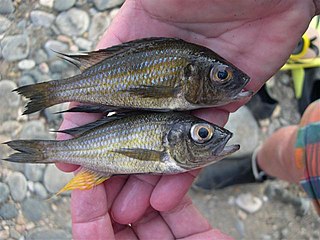 W
WAulonocranus dewindti is a species of cichlid endemic to Lake Tanganyika and some rivers which flow into it.
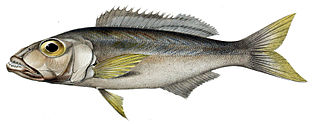 W
WBathybates is a genus of piscivorous cichlids endemic to Lake Tanganyika in East Africa. The genus includes both pelagic species that mainly feed on Tanganyika sardines and benthic species that mainly feed on other cichlids. They are some of the deepest-living cichlids, regularly occurring down to 200 m (660 ft).
 W
WBathybates ferox is a species of fish in the family Cichlidae. It is found in Burundi, the Democratic Republic of the Congo, Tanzania, and Zambia. Its natural habitat is Lake Tanganyika where it lives in shallow water and is exclusively piscivorous. The IUCN has assessed it as being a "least-concern species".
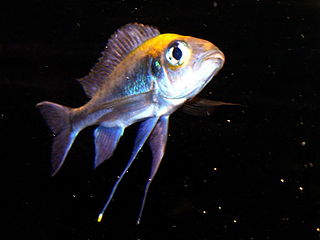 W
WThe featherfin cichlid is a species of cichlid endemic to Lake Tanganyika where it is found off rocky slopes. It feeds on plankton. This fish can reach a length of 21 centimetres (8.3 in) TL. It can also be found in the aquarium trade. This is currently the only species recognized in the genus by FishBase, but genetics and morphology suggest there are two valid species. The second is frequently called C. foae in the aquarium trade, but a review of the type specimen is needed to clarify if this is the correct name.
 W
WThe giant cichlid, also known as the emperor cichlid, is a species of fish in the family Cichlidae, endemic to Lake Tanganyika in Africa. It is the only member of its genus Boulengerochromis and tribe Boulengerochromini.
 W
WThe convict julie is a cichlid species in the subfamily Pseudocrenilabrinae family endemic to Lake Tanganyika. Hence it is found in Burundi, the Democratic Republic of the Congo, Tanzania, and Zambia. The fish is named after Charles Tate Regan.
 W
WCtenochromis horei is a species of haplochromine cichlid which is found in East Africa.
 W
WEctodini is a tribe of cichlids that are endemic to Lake Tanganyika in East Africa. They live in the benthic zone. Most of the genera in this tribe are monotypic. These fishes show diverse morphology and behaviour and the tribe includes taxa which live in sandy, muddy and rocky habitats.
 W
WEctodus descampsii is a species of cichlid fish endemic to Lake Tanganyika in East Africa where it prefers areas with substrates of coarse sand. It feeds on micro-organisms, algae and diatoms. This species reaches a length of 10.4 centimetres (4.1 in) TL. It is also found in the aquarium trade. It is currently the only known member of its genus. The specific name honours Capitaine Georges Descamps (1855-1938), a Belgian officer in the anti-slavery movement at Lake Tanganyika.
 W
WThe fourspine cichlid is a species of cichlid endemic to Lake Tanganyika where it lives in areas with sandy substrates. In addition to feeding on other fishes and insect larvae, this species is specialized to suck molluscs from their shells. This species can reach a length of 20 centimetres (7.9 in) TL. This species can also be found in the aquarium trade.
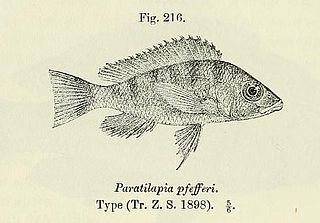 W
WGnathochromis pfefferi is an African species of fish in the family Cichlidae. It is endemic to Lake Tanganyika and its slow-flowing tributaries in the countries of Burundi, the Democratic Republic of the Congo, Tanzania and Zambia. It is common and widespread. This cichlid is found in relatively shallow waters, typically over soft bottoms in places with aquatic grasses.
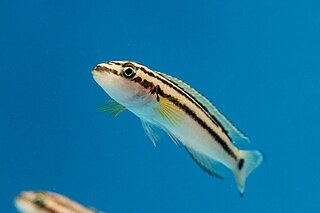 W
WThe golden julie is a species of cichlid endemic to Lake Tanganyika, being found only in the extreme northern and southern shorelines of the lake in rocky environs. This species reaches a length of 8.5 centimetres (3.3 in) TL.
 W
WGrammatotria lemairii is a species of cichlid endemic to Lake Tanganyika in East Africa where it prefers areas with sandy substrates. This species can reach a length of 26 centimetres (10 in) TL. It is currently the only known member of its genus. The species is occasionally kept as an aquarium fish. The specific name honours Lieutenant Charles Lemaire (1863-1925) who was the leader of the Congo Free State Expedition, which collected specimens of fishes at Lake Tanganyika, including the type of G. lemairii.
 W
WJulidochromis dickfeldi is a species of cichlid endemic to Lake Tanganyika in Africa where it is only known from the southwestern portion. This species inhabits areas with rock/rubble substrates, each fish maintaining a territory around a crevice or crack. This species reaches a length of 11 centimetres (4.3 in) TL. The specific name honours the German fishkeeper Alf Dickfeld who proposed the expedition on which the type was collected.
 W
WJulidochromis marlieri is a species of cichlid endemic to Lake Tanganyika where it is only known from the northwestern portion preferring rocky shorelines in deep waters. In the aquarium trade, it is commonly known as Marlier's Julie, Spotted Julie or Chequered Julie. This species reaches a length of 15 centimetres (5.9 in) TL. Adult females are larger than adult males. The specific name honours the Belgian zoologist Georges Marlier who collected the type.
 W
WThe Lake Tanganyika sardine is a species of freshwater fish in the family Clupeidae which was endemic to Lake Tanganyika but which has now been introduced to other lakes in Africa as a food source. It is monotypic within the genus Limnothrissa. It and the Lake Tanganyika sprat are known collectively as kapenta.
 W
WLepidiolamprologus boulengeri is a species of cichlid endemic to Lake Tanganyika where it is known from the Tanzanian coast in the northern part of the lake. Pairs of this species live together in their territory and the female lives in snail shells in a pit that they have dug in the sand. This species can reach a length of 6.2 centimetres (2.4 in) TL. This species can also be found in the aquarium trade. The specific name of this cichlid honours the Belgian born British ichthyologist and herpetologist George Albert Boulenger (1858-1937).
 W
WNeolamprologus mondabu is a species of cichlid endemic to Lake Tanganyika except for the southern portion where it is replaced by N. modestus. It prefers areas with rocky substrates, moving to areas with sandy substrates to breed. It feeds on the eggs of Lamprichthys tanganicanus. This species can reach a length of 10.7 centimetres (4.2 in) TL. This species can also be found in the aquarium trade.
 W
WNeolamprologus tretocephalus is a species of cichlid endemic to Lake Tanganyika where it is found in sandy areas in the northern half of the lake. It is a predator on molluscs. This species can reach a length of 15 centimetres (5.9 in) TL. This species can also be found in the aquarium trade.
 W
WParacyprichromis nigripinnis is a species of cichlid endemic to Lake Tanganyika where it is only known from the northern end of the lake. It can reach a length of 11 centimetres (4.3 in) TL. This species can also be found in the aquarium trade.
 W
WSynodontis grandiops is a species of upside-down catfish endemic to the Democratic Republic of the Congo, Burundi, and Tanzania, where it is only known from Lake Tanganyika. It was first described by Jeremy John Wright and Lawrence M. Page in 2006, from specimens collected at multiple points along the shore of Lake Tanganyika. The species name is a Latinized combination of the Latin "grandi", meaning large or big, and the Greek "ops", meaning eye, a reference to the relatively large eyes of this fish.
 W
WSynodontis granulosus is a species of upside-down catfish endemic to the Democratic Republic of the Congo, Burundi, Zambia, and Tanzania, where it is only known from Lake Tanganyika. It was first described by Belgian-British zoologist George Albert Boulenger in 1900, from specimens collected at multiple points along the shore of Lake Tanganyika. The species name comes from the Latin word "granulum", meaning of grain, and refers to the granular papillae present on the skin of the fish's body.
 W
WSynodontis multipunctatus, also known as the cuckoo catfish, cuckoo squeaker, or multipunk, is a small catfish from Lake Tanganyika, one of the lakes in the Great Rift Valley system in Africa. It is a brood parasite upon mouthbrooding cichlids. This species grows to a length of 27.5 centimetres (10.8 in) TL. This species is a minor component of local commercial fisheries.
 W
WThe Tanganyika killifish is a species of poeciliid endemic to Lake Tanganyika, where it forms large schools, mainly close to rocky shores but also pelagically off shore. This species grows to a length of 15 centimetres (5.9 in) SL. It is an egglayer with external fertilization, and deposits its eggs in narrow crevices. It is fished commercially for food, and also for the aquarium trade. It has been introduced to Lake Kivu.
 W
WTelmatochromis vittatus is a species of cichlid endemic to Lake Tanganyika usually at depths of from 5 to 10 metres but occasionally down to 20 metres (66 ft). This species can reach a length of 8.6 centimetres (3.4 in) TL. It can also be found in the aquarium trade.
 W
WTropheus annectens is a species of cichlid endemic to Lake Tanganyika, where it is found on a substrate consisting of large, fixed rock. This species can reach a length of 8 cm (3.1 in). It can be found in the aquarium trade.
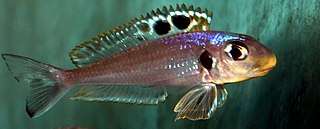 W
WXenotilapia bathyphila is a species of cichlid endemic to Lake Tanganyika where it occurs in schools in areas with sandy substrates. It feeds on small shrimps and copepods. This species can reach a length of 10.3 centimetres (4.1 in) TL. It can also be found in the aquarium trade.
 W
WXenotilapia papilio is a species of cichlid endemic to Lake Tanganyika in East Africa. It is found on the western shore of the lake, between Tembwe (Deux) and Kanoni in the Democratic Republic of the Congo. It prefers deeper, rocky habitats, especially where the rocks are covered with sand, at depths from 3–40 m (9.8–131.2 ft).